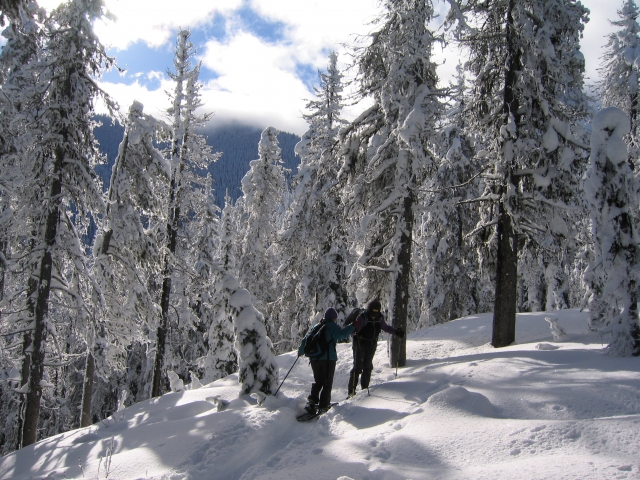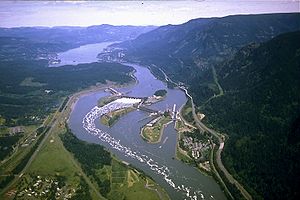Our New Rec Site: Some Facts (instead of all those rumours you've heard)
Some Questions and Answers
(Note: The questions below resulted from your reporter’s discussions with members of the community, and the answers are from reading the Rossland Range Recreation Site Management Plan and from discussions with members of the Friends of the Rossland Range Society (FoRRS) board of directors.)
Q: Why did FoRRS arrange to get this Recreation Site anyway?
A: It is to protect the space we still have for free public recreation on public land. People who use the Rossland Range for hiking, biking, skiing, and snowshoeing have been losing space to do those things for free. The Red Mountain Resorts Recreational tenure extends to the peak of Kirkup; and the Big Red Cats cat-skiing tenure has expanded; it now takes in, and has a sno-cat track along, the north ridge of Mt. Crowe, which was formerly a favorite route for back-country skiers and snowshoers.
Q: But isn’t all that official government status going to ruin our fun with the huts?
A: We had word from the Department of Forestry that if it weren’t for “that official government status” it is likely that the “Compliance” branch of the Ministry would come in and destroy our huts. As most people are aware, the huts are all “trespass” structures, and the government is beginning to take notice and remove such things. At least, they’re threatening to do that! It’s possible that the article in BC Magazine, featuring our hut area, brought the Rossland Range in particular to the attention of someone in government who decided that our little huts should no longer be tolerated. So the short answer is, our huts now have a bit of official protection, thanks to the Rec Site status. By the way, in official publications the huts must be referred to as “day use shelters,” but they are still “huts” to us.
Q: I’ve heard about some “Management Plan” for the site. Why do we have to have a management plan? Why can’t we just do things the way we always did?
A: The Rec Site status gives us a degree of protection for what we want, and to get that protection we have to be willing to engage in a bit of give-and-take with the government. The government requires a government-approved Management Plan. FoRRS engaged the community as much as possible to get public input into the Management Plan. The government’s requirements for hut standards are aimed at safety and health concerns, and they aren’t unreasonable. When our huts meet those standards we can take even more pride in them.
Q: I wasn’t asked for my opinion on this plan. Why not?
A: Invitations to provide your opinion were published in the Trail Times, the Rossland News, and the Rossland Telegraph, and over 400 people who are on the FoRRS mailing list received personal e-mail invitations to give their input. Before that, public consultation took place in community meetings over the course of about two years. There’s only so much FoRRS can do to get information from people.
Q: Doesn’t the Management Plan say we have to get rid of some of the huts now?
A: Well, not immediately. There are some huts that have fallen into disrepair and are now little used; for instance, Buffalo Jump. So Buffalo Jump is probably for the high jump. It always did have a rat-infestation problem. Crowe’s Nest, built quite high on Mount Crowe, has another problem — it’s causing adverse environmental effects because of its appetite for firewood at an elevation where firewood cannot grow back as fast as we’re using it up, and the wildlife who depend upon the snags cut for firewood are suffering. Another hut that could be taken down is TeePee — if anyone can find it to take it down.
Q: Doesn’t the plan require us to “consolidate” two huts into one new hut in some places?
A: Yes, it does, for now. One of the first such “consolidations” might be the removal of Crowe’s Nest and the building of a new, improved Mosquito. Another will involve using materials from the new hut known by some as “Defiance” to improve “View” hut to the new standards. As for others, time will tell. The plan is not carved in stone, and many of us hope to prove to the government that a larger number of huts than currently authorized is not unreasonable — that it best serves the interests of the community, and doesn’t interfere with the forestry tenure holder. If all the huts are being brought up to the required standards and are well maintained — then we hope to justify having the huts, and seek approval for an amended plan that includes them. But we have to work at this gradually.
FoRRS has asked Les Carter to be the coordinator for work on the huts. His role is to help interpret the plan, facilitate communication, provide guidance about hands-on issues such as construction, and help find funding and resources. He assures us that he welcomes input on the huts. His contact information is noted along with others at the end of this article.
Q. What’s wrong with Mosquito as it is?Isn’t it one of the most popular huts?
A: Yes, Mosquito is very popular. But it doesn’t meet the new standards required of Rec Site huts — day-use shelters — and firewood is becoming a bit scarce in its vicinity. That’s partly because it is just too accessible to people arriving by motor vehicle in the summer months, and some of those people come and have summer bonfires with all the firewood gathered by volunteers for the winter; and someone has stolen the Mosquito axe (which was donated by other community members) a few times. The people who look after Mosquito are considering building a replacement a bit further up the hill, further from the road. Ideas on where to put the next Mosquito are welcome! If you have ideas about that, send them to Les Carter.
Q: I saw the map with the suggested places for new huts and I don’t like where a couple of them are supposed to go. Can that be changed?
A: Yes, those placement zones are very tentative and were only intended to give initial suggestions — just to indicate that a new hut would be somewhere between the two that it’s intended to replace. There aren’t any firm decisions yet about the locations of new cabins.
Q: Does the Rec Site status give us any other advantages besides being able to have huts?
A: Yes! With that official status, we can now start looking for funding opportunities, and writing grant applications, for things like materials for new huts, safe stoves and proper stovepipe, functional outhouses that people aren’t afraid to use, and so on. The government requires certain standards for the huts, and the Rec Site approval gives us the status to apply for funding to meet those standards. It also provides public liability insurance which can cover volunteers.
Q: Insurance? You mean if I get hurt while I’m cutting firewood for a hut, I’d be covered?
A: If you were using a chain saw, you would have to take the course on operating chain saws safely to be covered by the insurance. Selkirk College offers it, and there may be an opportunity for a course in Rossland sponsored by the Ministry of Forests.
Q: I’ve heard that we can do a bit of thinning in the new plantations, where they’ve grown up so thick that a person on skis can’t get through them anymore. Is that true?
A: Yes — as long as we consult with the forestry tenure holder, Atco Wood Products Limited, first, to get their approval and then do the thinning to their standards. Atco has been very accommodating, and we should return the favour.
Q: So how do we consult with Atco, and what ARE the standards?
A: First, communication with Atco is key, and one person has volunteered for that role, so that Atco isn’t bombarded with calls from a lot of people. Also, FoRRS is the entity tasked with overseeing the Management Plan, so someone from FoRRS should be able to keep track of what’s happening. So if you want to clear a route for skiing and snowshoeing through the dense growth of new pines, please contact Gerry Heacock. His e-mail address is: gheacock@ualberta.caand his phone number is 250-777-1799. Then Gerry will talk to Atco, and get back to you.
As for standards: trees should be spaced 2.7 meters apart — that’s 8 feet 10 inches, for some of us. That’s all the room needed for a path, so there’s no excuse for cutting planted trees. Self-sowed trees growing up among the planted trees can be cut out to the same spacing. Where the lower branches of the larger new growth are a problem, those branches can be carefully trimmed — without doing any damage to the trunk of the tree. If branches are trimmed on one side of a tree, they should be trimmed all the way around the tree at that level to keep the tree balanced.
Alders can always be cut without any consultation, and in the mature forest, if trees have fallen, they can be cut into pieces so that they don’t “bridge” gullies – but it’s still better to talk with Gerry so he can keep Atco informed. (But please don’t cut any huckleberry bushes, eh?)
Q: That’s a lot to absorb. What if I have more questions later?
A: You could try reading through the Management Plan and see if it answers your questions. It’s easy to find at the FoRRS website, and a map is there too:
If you don’t want to read that, you can contact members of the FoRRS board; they want to know what questions people have, and they can answer them:
Bob Bechaud bechaud@telus.net
Troy Colautti troyc@telus.net
Jenny Coleshill jencoleshill@yahoo.ca
Kim Deane kdeane@shaw.ca (250)-362-5648
Les Carter retrac01@telus.net (250)-362-5677
Rejean Paquin paquinresu@yahoo.ca (250)-362-6809
Suzanne Paquin paquinresu@yahoo.ca (250)-362-6809
Sheree Sonfield sonfield@telus.net
Stewart Spooner stewspooner@gmail.com (250)-368-1440
Gary Westbury mmwhistle@gmail.com
There. I hope that helps. As a frequent wanderer in our lovely hills, and as a builder and user and advocate for our huts, I’m intensely interested in how the Rec Site plays out, and I know many others are too.


























